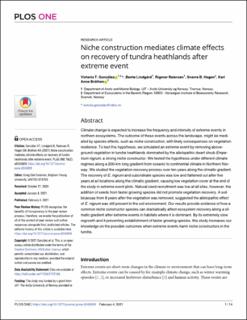| dc.contributor.author | Gonzalez, Victoria | |
| dc.contributor.author | Lindgård, Bente | |
| dc.contributor.author | Reiersen, Rigmor | |
| dc.contributor.author | Hagen, Snorre | |
| dc.contributor.author | Bråthen, Kari Anne | |
| dc.date.accessioned | 2021-12-01T09:37:11Z | |
| dc.date.available | 2021-12-01T09:37:11Z | |
| dc.date.created | 2021-05-28T14:07:36Z | |
| dc.date.issued | 2021-02-04 | |
| dc.identifier.citation | PLOS ONE. 2021, 16 (2), . | en_US |
| dc.identifier.issn | 1932-6203 | |
| dc.identifier.uri | https://hdl.handle.net/11250/2832285 | |
| dc.description.abstract | Climate change is expected to increase the frequency and intensity of extreme events in northern ecosystems. The outcome of these events across the landscape, might be mediated by species effects, such as niche construction, with likely consequences on vegetation resilience. To test this hypothesis, we simulated an extreme event by removing aboveground vegetation in tundra heathlands dominated by the allelopathic dwarf shrub Empetrum nigrum, a strong niche constructor. We tested the hypothesis under different climate regimes along a 200-km long gradient from oceanic to continental climate in Northern Norway. We studied the vegetation recovery process over ten years along the climatic gradient. The recovery of E. nigrum and subordinate species was low and flattened out after five years at all locations along the climatic gradient, causing low vegetation cover at the end of the study in extreme event plots. Natural seed recruitment was low at all sites, however, the addition of seeds from faster growing species did not promote vegetation recovery. A soil bioassay from 8 years after the vegetation was removed, suggested the allelopathic effect of E. nigrum was still present in the soil environment. Our results provide evidence of how a common niche constructor species can dramatically affect ecosystem recovery along a climatic gradient after extreme events in habitats where it is dominant. By its extremely slow regrowth and it preventing establishment of faster growing species, this study increases our knowledge on the possible outcomes when extreme events harm niche constructors in the tundra. | en_US |
| dc.language.iso | eng | en_US |
| dc.publisher | PLOS | en_US |
| dc.rights | Navngivelse 4.0 Internasjonal | * |
| dc.rights.uri | http://creativecommons.org/licenses/by/4.0/deed.no | * |
| dc.title | Niche construction mediates climate effects on recovery of tundra heathlands after extreme event | en_US |
| dc.type | Peer reviewed | en_US |
| dc.type | Journal article | en_US |
| dc.description.version | publishedVersion | en_US |
| dc.rights.holder | © 2021 González et al. | en_US |
| dc.source.pagenumber | 14 | en_US |
| dc.source.volume | 16 | en_US |
| dc.source.journal | PLOS ONE | en_US |
| dc.source.issue | 2 | en_US |
| dc.identifier.doi | 10.1371/journal.pone.0245929 | |
| dc.identifier.cristin | 1912556 | |
| dc.relation.project | Norges forskningsråd: 302749 | en_US |
| dc.source.articlenumber | e0245929 | en_US |
| cristin.ispublished | true | |
| cristin.fulltext | original | |
| cristin.qualitycode | 1 | |

